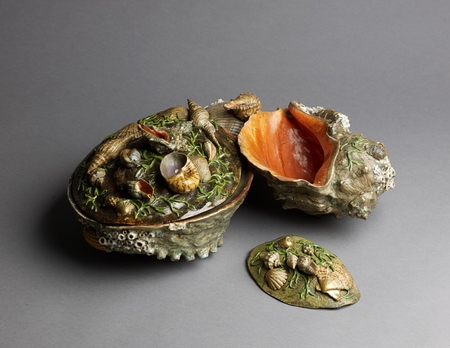Product Description
7018 Attributed to Ogawa Haritsu (1663-1747)
A multi-coloured glazed ceramic iremono (box) with two sections in the form of a cluster of shells
The largest being an upturned awabi (abalone) and the other a sazae (horned turban) resting against a closed clam encrusted with barnacles. Each one has a separately fashioned lid decorated with different varieties of crustacea interspersed with seaweed.
Japan 18th century Edo period
Dimensions: H. 13cm x W. 32cm x D. 27.5cm (5¼” x 12¾” x 11″)
Label on awasebako (fitted box):
Haritsu saku kaizukushi (Made by Haritsu. Assortment of shells)
Ogawa Haritsu (1663-1747). Sobriquet: Ritsuō. Gō (art names): Bōkanshi, Hanabusa Issen, Haritsu, Kanshi, Muchūan, Sōu, Ukanshi. Haritsu was born in Ise but lived and worked in Edo, an accomplished painter and potter, he is most noted for his instantly recognisable lacquer work. Known to have entered the service of the daimyo of Tsugaru in Mutsu, he studied haiku (poetry) under the famous poet Matsuo Bashō (1644-1694), painting with Hanabusa Itchō (1652-1724) and lacquer in the Kōetsu tradition. Haritsu was also friends with poets Takarai Kikaku (1661-1707) and Hattori Ransetsu (1654-1707).
In lacquer, he introduced a vocabulary of new materials not usually associated with lacquer artists such as glazed ceramic pieces, mother of pearl and lead. Haritsu also mastered the technique of making lacquer surfaces appear to resemble other materials such as bronze, tile, ink sticks and potter, a style of decoration which became known as Haritsu saiku.







